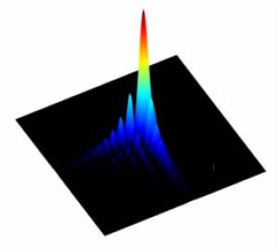November 29, 2007 feature
Scientists make first observation of Airy optical beams

Scientists have made the first observation of an unusual class of optical waves called Airy beams. Unlike most types of light waves, Airy beams have the ability to resist diffraction over long distances, and can also freely accelerate during propagation.
The researchers, Georgios Siviloglou, John Broky, Aristide Dogariu, and Demetrios Christodoulides from CREOL-University of Central Florida (UCF), hope that these unusual features may enable Airy beams to be used in applications such as particle manipulation and in nonlinear media. The group’s study, published in a recent issue of Physical Review Letters, reports the observation of Airy beams in both one- and two-dimensional configurations.
Airy beams take their name from the “airy integral,” introduced by Sir George Biddell Airy in the 1830s to explain optical caustics such as those appearing in a rainbow. Airy beams were initially predicted in 1979 by two scientists, Michael Berry and Nandor Balazs, within the context of quantum mechanics. The scientists theorized the existence of a free particle described by the Schrödinger equation that could exhibit an Airy wave packet that doesn’t spread out as it propagates—in other words, it is diffraction-free. Remarkably, an Airy wave packet has the unusual ability to freely accelerate even in the absence of an external stimulus.
“We are not sure why this absolutely fascinating prediction went unnoticed for so long given the fame of Michael Berry,” Christodoulides told PhysOrg.com. “We think that it is partly due to the fact that it was initially published in a relatively ‘obscured’ journal. The second issue has to do with experimental implementation. It is only very recently that we realized that exponentially truncated Airy beams have a Gaussian power spectrum and can thus be easily synthesized from standard Gaussian beams.”
The UCF researchers noted that other two-dimensional diffraction-free light waves exist, such as the so-called Bessel beam, which is generated by a conical superposition of plane waves. Due to their non-diffracting nature, Bessel beams theoretically convey an infinite power. However, lack of space and power causes the beams to truncate and therefore diffract during propagation.
In contrast to Bessel beams and other non-spreading waves, Airy beams do not result from conical superposition. Rather, the researchers generated Airy beams by using a computer-controlled spatial light modulator, which modulated the phase of a Gaussian beam, which was then imaged on a CCD camera. The scientists used different phase masks to generate either one- or two-dimensional Airy beams.
The researchers observed that the local intensity features of the Airy beams tended to freely accelerate. This is because these beams are analogous to the probability wave function of a quantum mechanical particle when observed in a free-falling reference frame. Despite the beam’s center of mass remaining constant, the beam’s local intensity features follow a bent parabolic trajectory over distances up to 25-30 cm before experiencing diffraction. By contrast, a normal Gaussian beam of the same size would have expanded 24 times in this distance.
“These beams have the ability to freely accelerate or self-bend during propagation while remaining invariant in shape,” Christodoulides explained. “Light is known to travel along straight paths. In contrast, in our case, the intensity features of Airy waves, follow parabolic or ballistic trajectories, very much like those of a projectile (fired from a canon) moving under the action of gravity.”
The scientists explained that, due to the ability to separately adjust the x and y parameters of Airy beams, the acceleration of the non-diffracting beam can be controlled. The researchers also suggested that a slightly different technique for generating one-dimensional Airy wave packets may lead to the first observation of non-dispersing Airy pulses in optical fibers. Further, non-diffracting Airy beams may also be useful for particle manipulation or in nonlinear media.
“These beams are highly asymmetric in their intensity,” said Christodoulides. “There are several applications in probing where this may be desirable. In addition, the fact that the main lobe of these beams (which conveys more than 50% of the beam’s energy) does not travel along straight paths can be used to ‘push’ particles sideways through radiation pressure.”
More information: Siviloglou, G. A., Broky, J., Dogariu, A., and Christodoulides, D. N. “Observation of Accelerating Airy Beams.” Physical Review Letters 99, 213901 (2007).
Copyright 2007 PhysOrg.com.
All rights reserved. This material may not be published, broadcast, rewritten or redistributed in whole or part without the express written permission of PhysOrg.com.




















